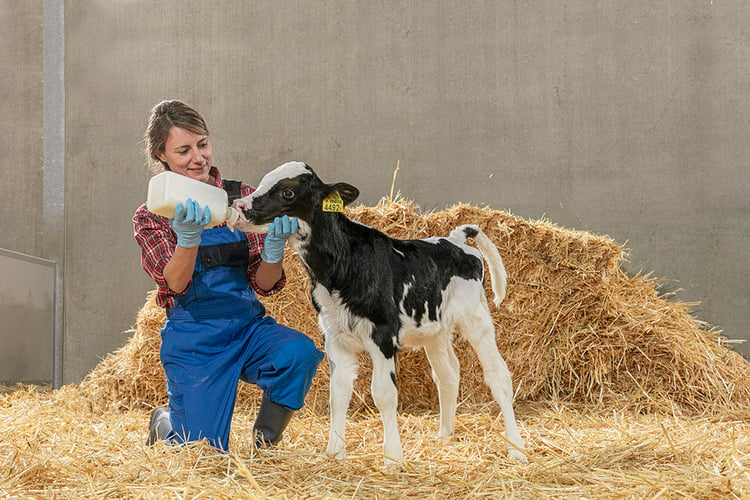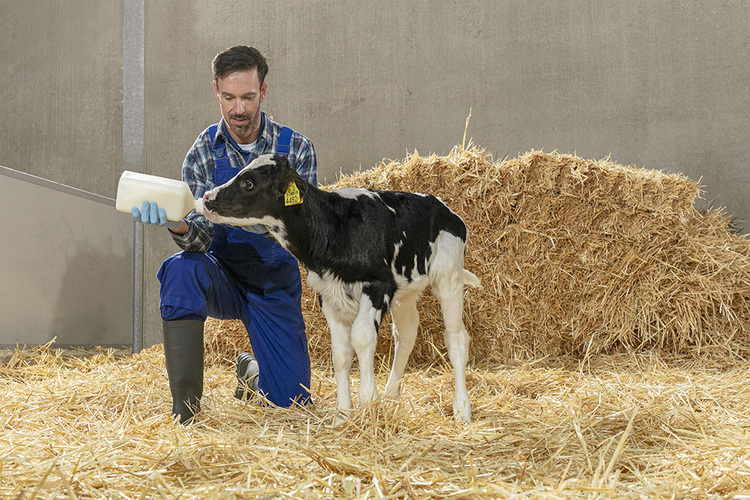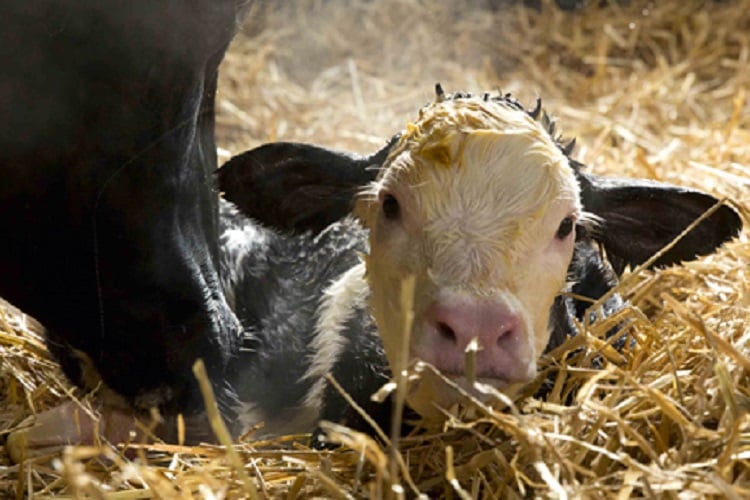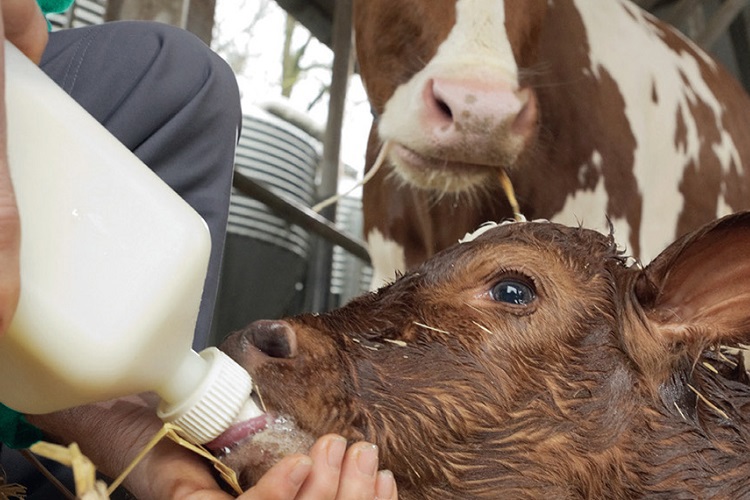- LifeStart
- Colostrum Management
Key takeaways from the research:
-
Transfer of passive immunity to calves via colostrum is important to protect them against disease while their immune system develops.
-
Colostrum contains other factors that are important for calf growth and performance, such as IGF-I, IGF-II, growth hormone, insulin, prolactin and leptin
-
These factors are also important for the development of gastro-intestinal tract function.
-
Increasing levels of pre-weaning nutrition lead to higher growth rates pre-weaning and post-weaning.
-
Increasing levels of pre-weaning nutrition also lead to better lactation performance later in life.

Metabolic programming through optimizing colostrum management and feeding high planes of nutrition
Metabolic programming, otherwise known as neonatal imprinting, has been studied in a variety of species. Over the last 30 years, specific research into bovines and metabolic programming has been plentiful and researchers have tried to optimize health and growth via particular methods of feeding and management during the first stages of an animal's life. They have studied what parameters are necessary to achieve optimal calf health and growth that could, in turn, lead to optimal performance. In her doctoral dissertation entitled, "Impact of prenatal and neonatal nutrition on metabolism and future performance in dairy heifers,[1] Dr Christina Yunta gives an extensive overview of recent research related to both the short- and long-term effects of high-quality colostrum feeding and increased amounts of milk feeding during the fed pre-weaning period.
The effects of colostrum on health and metabolism
The importance of feeding newborn calves an adequate volume of high-quality colostrum to ensure optimal transfer of passive immunity is widely understood. If calves have a serum concentration of 10 mg of IgG/mL 48 hours after birth, transfer of passive immunity is considered to be successful.[2] To obtain this level of 10 mg IgG/ml, feeding four litres of colostrum immediately after birth is sufficient and will lead to a reduction of veterinary costs compared feeding two litres of colostrum only.[3]
Next to immunoglobulins, colostrum is both rich in nutrients and bioactive compounds, such as hormones and growth factors that influence post-natal development, growth and performance. Bioactive factors such as insulin-like growth factor (IGF-I), IGF-II, growth hormone (GH), insulin, prolactin (PRL) and leptin can influence postnatal intestinal development.[4] They modulate the gastrointestinal tract (GIT) by influencing cell proliferation, digestion, and immune system development, as well as by influencing functions outside of the GIT.[5]
There is a growing body of evidence that shows that colostrum has a significant impact on the glucose metabolism of calves. Colostrum intake enhances glucose absorption by increasing intestinal surface[6] and improving lactose digestion. Calves that were fed sufficient volumes of high-quality colostrum had greater insulin concentrations after meals than calves that did not receive colostrum.[7]
Effects of high pre-weaning levels of feeding on growth and performance
Calves fed the traditional pre-weaning diet that restricts milk allowances had both low growth rates[8] and high mortality rates.[9] Higher growth rates were achieved through increasing the amounts of milk fed.[10] In the past, it was thought that increasing the amount of milk fed would increase the risk of scours, but this has recently been contraindicated in several studies,[11] if proper management techniques, coupled with quality, well-formulated calf milk replacer are being applied.
Other research points to the link between a higher plane of early life nutrition and a higher milk production later in life. Calves that were fed large amounts of whole milk had a greater milk yield during their first lactation than restricted calves.[12] Other studies show that increased nutrient intake (which leads to higher ADGs) during the crucial first weeks of life leads to greater milk yield during the first lactation.[13] This may be due to the increased calving bodyweight of those fed a higher plane of nutrition pre-weaning, as there is a strong correlation between the two. Indeed, increasing the plane of nutrition pre-weaning brings about higher ADGs, which research has shown, in combination with proper management during and after weaning, leads to sustained higher body weights long after transitioning to solid feed.
Conclusions
Ensuring that the proper amount of high-quality colostrum is fed to calves just after birth is essential in order for calves to reap the benefits of both IgG's and other vital colostral factors that positively affect calf health and metabolism. Additionally, raising the plane of pre-weaning nutrition aids in both short- and long-term calf growth and future lactation performance.
References
[1] Yunta, C. (2015) Short- and medium-term changes in performance and metabolism of dairy calves offered different amounts of milk replacer (Doctoral dissertation). Universitat Autonoma de Barcelona, Spain.
[2] Donovan, G.A., Badinga, L., Collier, R.J., Wilcox, C.J., Braun, R.K. Factors influencing passive transfer in dairy calves. J. Dairy Sci. 1986; 69:754–759. Robison, J.D., Stott, G.H., DeNise, S.K. Effects of passive immunity on growth and survival in the dairy heifer 1, 2. J. Dairy Sci. 1988;71:1283–1287 (3135297). Selim SA, Smith BP, Cullor JS, Blanchard P, Farver TB, Hoffman R et al., 1995, Serum immunoglobulins in calves: their effects and two easy reliable means of measurement, Vet Med, 90, 4 387-404.
[3] Faber, S.N., Faber, N.E., McCauley, T.C., Ax, R.L. Case study: Effects of colostrum ingestion on lactational performance. Prof. Anim. Sci. 2005; 21:420–425.
[4] Odle, J., Zijlstra, R.T., Donovan, S.M. Intestinal effects of milkborne growth factors in neonates of agricultural importance. J. Anim. Sci. 1996; 74:2509–2522. J. W. Blum 2006. Nutritional physiology of neonatal calves. J. Anim. Physiol. Anim. Nutr.90:1–11.
[5] Blum, 2006. Op. Cit.
[6] Hammon, H.M., Steinhoff-Wagner, J., Flor, J., Schönhusen, U., Metges, C.C. Lactation Biology Symposium: Role of colostrum and colostrum components on glucose metabolism in neonatal calves. J. Anim. Sci. 2013; 91:685–695.
[7] Blum, J.W., Hammon, H. Endocrine and metabolic aspects in milk-fed calves. Domest. Anim. Endocrinol. 1999; 17:219–230.
[8] Flower, F.C., Weary, D.M. Effects of early separation on the dairy cow and calf. II: Separation at 1 day and 2 weeks after birth. Appl. Anim. Behav. Sci. 2001; 70:275–284.
[9] NAHMS. 2007. Dairy 2007, Part I: Reference of Dairy Cattle Health and Management Practices in the United States.
[10] Jasper, J., Weary, D.M. Effects of ad libitum milk intake on dairy calves. J. Dairy Sci. 2002; 85:3054–3058. Diaz, M.C., Van Amburgh, M.E., Smith, J.M., Kelsey, J.M., Hutten, E.L. Composition of growth of Holstein calves fed milk replacer from birth to 105-kilogram body weight. J. Dairy Sci. 2001; 84:830–842. Quigley, J.D., Wolfe, T.A., Elsasser, T.H. Effects of additional milk replacer feeding on calf health, growth, and selected blood metabolites in calves. J. Dairy Sci. 2006; 89:207–216.
[11] Jasper and Weary, 2002. Op. Cit. And Terré, M., Tejero, C., Bach, A. Long-term effects on heifer performance of an enhanced-growth feeding programme applied during the pre-weaning period. J. Dairy Res. 2009; 76:331–339.
[12] Shamay, A., Werner, D., Moallem, U., Barash, H., Bruckental, I. Effect of nursing management and skeletal size at weaning on puberty, skeletal growth rate, and milk production during first lactation of dairy heifers. J. Dairy Sci. 2005; 88:1460–1469. And Drackley, J.K., Pollard, B.C., Dann, H.M., Stamey, J.A. First-lactation milk production for cows fed control or intensified milk replacer programs as calves. J. Dairy Sci. 2007; 90:779 (Abstr.).
[13] Bach, A., Ahedo, J. Record keeping and economics of dairy heifers. Vet. Clin. North Am. Food Anim. Pract. 2008; 24:117–138. Bach, A. Ruminant Nutrition Symposium: Optimizing Performance of the Offspring: Nourishing and managing the dam and postnatal calf for optimal lactation, reproduction, and immunity. J. Anim. Sci.2012; 90:1835–1845. And Soberon, F., Raffrenato, E., Everett, R.W., Van Amburgh, M.E. Preweaning milk replacer intake and effects on long-term productivity of dairy calves. J. Dairy Sci. 2012; 95:783–793.
[14] Bach and Ahedo, 2008. Op. Cit. And Keown, J.F., Everett, R.W. Effect of days carried calf, days dry, and weight of first calf heifers on yield. J. Dairy Sci. 1986; 69:1891–189.



